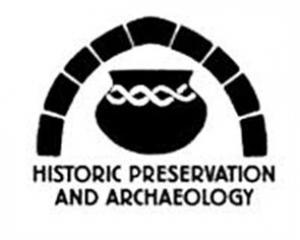
Indiana Archaeology Award - The DNR presents awards annually to recognize outstanding efforts in historic preservation and archaeology. This year’s Indiana Archaeology Award was presented to Cardno archaeologist Ryan Peterson. As Principal Investigator, he successfully managed a large-scale archaeological excavation project for moving the historic Bethel Cemetery (CR-49-12; 12Ma1025) in Marion County. The award recognizes his coordination and leadership regarding this huge and detailed project, and for the efforts made to involve, and keep informed, descendants of those buried in the cemetery.
Ryan did a great job coordinating and leading the archaeological effort for this Section 106 project, and there was close coordination and communication between Cardno, the DHPA, the Indianapolis Airport Authority, and the Federal Aviation Administration.
Collaboration also took place with archaeologists from several universities and other CRM firms, and new and innovative technologies were incorporated to record the burials and other features of the cemetery. The amount of research and analyses completed thus far regarding this cemetery and the individuals buried there is impressive. For many years to come, new and exciting research in archaeology, cemetery studies, and other disciplines will result as well.
Reinterment took place, and the Bethel Cemetery is now part of Concordia Cemetery on the south side of Indianapolis.
Please join us in congratulating Ryan Peterson for an outstanding job as Principal Investigator regarding the careful and sensitive archaeological disinterment and analyses of over 500 graves.

Archaeology Site of the Month - In honor of the 25th anniversary of a statewide celebration of Indiana archaeology, we are highlighting the 25th recorded archaeological site for each county! This focus will span all 92 counties over the next year. Archaeological sites are each given a unique, sequential identification number as they are recorded. This helps archaeologists keep track of the artifacts that come from the site and differentiates it from other sites in the area. The numbering system tells archaeologists what state and county a site comes from, and what the specific number in that county belongs to the site. For example, Angel Mounds is archaeological site 12-Vg-1, meaning it is from Vanderburgh County (Vg), Indiana (12), and is the first documented site in that county (1). In this newsletter, we are highlighting the 25th site from Floyd through Greene counties.
Floyd County, 12-Fl-25: This site was reported in 1982 by a landowner who regularly recovered artifacts from his property. The site yielded diagnostic artifacts from the Early Archaic to the Mississippian. To date, no professional archaeological investigations have been conducted at the site.
Fountain County, 12-Fo-25: This camp site was reported to Indiana State University in 1967. Although no artifacts are listed on the site form, the site is noted as being approximately 3 acres in size, meaning it is either a substantial site or a widely dispersed scatter of artifacts.
Franklin County, 12-Fr-25: Frank Setzler first reported this site in 1930 as part of his survey of the Whitewater Valley. Also known as Village Site No. 1 or the Masters Village Site, Setzler described the site as being the “most fertile village site in the county …” (Setzler 1930).
Fulton County, 12-Fu-25: This site was documented as part of the General Land Office Survey (GLO) records grant project completed by Ball State University (Maust 1982). Originally recorded in 1834, this site is a historic-era cornfield that is associated with 12-Fu-24, a Trading House. Site 12-Fu-25 has yet to be archaeologically investigated.
Gibson County, 12-Gi-25: D.W. Dragoo reported this site in 1950 and recovered a scatter of flint flakes. He also noted the presence of three possible mounds, but was unable to determine whether they were natural or man-made.
Greene County, 12-Gr-25: This is a Woodland-era village site that was reported by the DNR, Division of Reclamation in 1985. The site was originally recorded by Glenn A. Black in 1933. The 1985 investigations at the site took place in order to assess the site’s integrity in advance of a mining project. It was recommended that the site be avoided by project activities, and to our knowledge it has been protected from mine-related disturbance.

Site Visit - DHPA archaeologists Rachel Sharkey and Wade Tharp, and DHPA Director Beth McCord visited the State Line Site in Dearborn County on October 13. This impressive site is out of the ordinary because, as the name implies, it straddles the Indiana/Ohio state line, and the Ohio portion is listed on the National Register of Historic Places. The primarily Ft. Ancient site is currently being investigated by ASC Group, Inc. as part of an intersection improvement project. If you are interested in the Ft. Ancient culture, check out the Swihart et al. 2017 article in Volume 12(1) and the Moore and Raymer 2014 article in Volume 9(1) of Indiana Archaeology.
SHAARD Tip - The Indiana Historic Buildings, Bridges, and Cemeteries Map is supported and powered by Esri. Esri is available on any internet search engine and web browser and can be accessed at any time. Keep in mind that the different search engines may present the map in different ways, so if the map and tools look slightly different than the screen shots found in the User Guide, do not be alarmed. The User Guide was created by accessing the map in Chrome. There have been some reports that Safari is not always compatible with all the map functions. Find the user guide at https://www.in.gov/dnr/historic/4505.htm.

Long-term Service - On November 25, State Archaeologist Amy Johnson begins her 30th year of working full-time at the Division of Historic Preservation and Archaeology. Prior to being hired full-time in 1991, Ms. Johnson was a grant-funded DHPA employee from February-October 1990 and helped to enter more than 11,000 archaeological site forms into the start of what is now the DHPA’s archaeology database in SHAARD. She has been the State Archaeologist for five years.
Announcement of Project - Just over a year ago, State Archaeologist Amy Johnson approached our Director, Beth McCord, with an idea for a new way for the DHPA to share information with the public regarding archaeology in our state. She proposed a digital document that would highlight an archaeological site from each of Indiana’s 92 counties. In addition to DHPA archaeologists, she proposed involving archaeology colleagues who would volunteer to write the features for a general audience. Beth agreed that this would be a great, collaborative way to share archaeological information with the public, and the project took off from there.
The DHPA put the call out to our archaeological colleagues who might be interested in volunteering, and the response has been much appreciated. Archaeologists have chosen their site(s) to highlight based upon past fieldwork they have conducted, a research interest in a particular site (precontact or historical), or for a variety of other reasons. Amy Johnson is the Editor of the submissions, with Co-Editors Rachel Sharkey and Beth McCord.
Highlighting Hoosier Archaeological Sites: Examples from 92 Counties will be a StoryMap through ArcGIS on the Division of Historic Preservation and Archaeology webpage where viewers will be able to click on a county and read about the featured site. In the future, additional sites and case studies per county may also be added.
Archaeologists from many Indiana state agencies and state-sponsored institutions routinely perform projects throughout the state. In the StoryMap documents, we try to minimize the technical details and summarize the facts into a simple format, integrating photographs, diagrams, and maps where possible to better educate and inform the public about the practice and significance of archaeology around Indiana. We thank our many archaeology colleagues who have thus far contributed to the project. There are still counties which have not been spoken for, so if you are a professional archaeologist and would like to contribute, reach out to Amy Johnson at ajohnson@dnr.IN.gov.
We will let you know when the StoryMap is available and hope you will check out this exciting new public archaeology initiative.
- Outreach-
* Elementary Outreach - Rachel Sharkey spoke about Indiana archaeology to a 5th grade class at Allisonville Elementary on October 27. The talk covered the who-what-whys of archaeology in our state and included a Cookie Excavation. Students “excavated” colored chocolate chips from cookies, representing different types of artifacts, and then interpreted their “site” before eating it.

Mission Statement: The Division of Historic Preservation and Archaeology promotes the conservation of Indiana’s cultural resources through public education efforts, financial incentives including several grant and tax credit programs, and the administration of state and federally mandated legislation.
Division of Historic Preservation and Archaeology, 402 W. Washington St., Room W274, Indianapolis, IN 46204. www.IN.gov/dnr/historic, www.facebook.com/INdhpa
Indiana Archaeology Month (September) webpage - http://www.in.gov/dnr/historic/3674.htm
#INArchaeoMonth
Find the Division of Historic Preservation and Archaeology on Facebook.
Compiled by Amy Johnson, State Archaeologist, Archaeology Outreach Coordinator, and Team Leader for Archaeology (November 2020). Text also provided by Rachel Sharkey and Jeannie Regan-Dinius. #ArchaeoNewsIN

